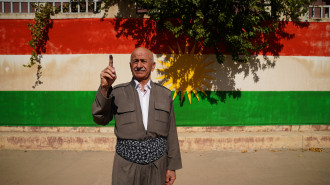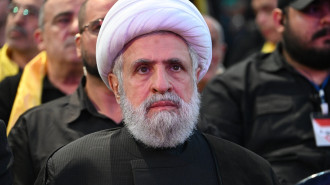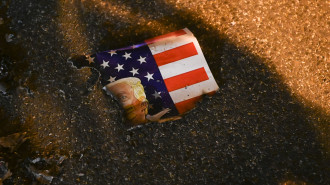Syria Weekly: Russia begins to rebuild Syria's military from scratch
Syria Weekly: Russia begins to rebuild Syria's military from scratch
Russia is helping the Syrian regime rebuild its military after eight years of war showed the dire state of the armed forces.
6 min read
Another key Syrian air force base became fully operational again this week, according to reports in opposition media, with sources telling The New Arab that the regime is looking to embark on a post-war transformation from an informal, militia-heavy force to a professional military.
Kuweires military airbase in the Aleppo province – a one-time training centre for air force officers – had been operational to some degree since 2017, when state media reported that jets had landed on its airstrip.
Kuweires military airbase in the Aleppo province – a one-time training centre for air force officers – had been operational to some degree since 2017, when state media reported that jets had landed on its airstrip.
Repairs have been made since then to the damage wrought from a punishing three-year siege and heavy fighting during its recapture. Kuweires was semi-abandoned by the regime from 2013 following its encirclement by rebel forces and then the Islamic State group, with the garrison left to fend for themselves despite some supplies reaching the defenders.
Kuweires could not return to the key role it played in the Syrian Air Force before the war due to its hosting of the Military Aviation Institute, where many of the country's pilots gained their wings. It appears the base is now gearing up to take in more cadets, after most pilot training courses were put on hold during the war.
Syrian news site Zaman Al-Wasl reported this week that air force officers and personnel have started to move back to Kuweires after being stationed at other bases for the duration of the war. A flight school for cadets was set up at the Shayrat airbase in Homs when the Aleppo base suspended courses in 2013 due to a rebel siege. After eight years of war the Syrian Air Force is a skeleton of its former self, suffering from a serious shortage of aircraft and trained personnel due to losses, defections and financial constraints despite the devastation it has inflicted on much of the country.
 |
|
The air force also lacks trainer jets for the next generation of pilots with most cadets returning to Kuweires with only 25 hours of flytime, the Syrian website stated, instead of the 100 hours needed to graduate from the academy. Only 22 of the base's 100 Soviet-era Aero L39 Albatross jets have survived the war, according to the site, with more of the trainer aircraft returning to Kuweires from other airfields such as Shayrat in the Homs province.
Kuweires was completely encircled by Islamic State group militants or rebel fighters for three years, until regime forces relieved the base in November 2015, although clashes continued. The Free Syrian Army's war with IS in northern Syria saw the latter takeover the area and intensify the siege on Kuweires.
A brief window in the rebel-IS fighting allowed the regime to reinforce the base with more troops, according to Bellingcat. But airfields such as Kweires were left with just a small number of troops to defend them from attacks, while Damascus' concentrated its depleted forces on taking back urban areas in central Syria. This included putting training for air force pilots on hold.
"All training for pilot cadets was stopped during the war and a lot of bases and academies were abandoned by the government," one source told The New Arab.
"All training for pilot cadets was stopped during the war and a lot of bases and academies were abandoned by the government," one source told The New Arab.
Only 312 troops – almost all reportedly injured – of the original 1,100 personnel trapped at Kuweires airbase survived the siege according to Robert Fisk, who visited the airbase on a regime junket in 2016. The troops had lived for years without power and ate only every two days under a regular barrage of artillery and gunfire. Personnel managed to survive largely due to a helicopter fleet flying in supplies and ammunition. IS, meanwhile, enforced a social media blackout on its militants to prevent the air force locating their positions, according to Syria war monitor, Oryx.
Although IS militants managed to launch several assaults on the base, and twice breached it perimeter, they were forced back, although some aircraft and buildings were damaged in the clashes.
The regime's recapture of the base was only possible due to the intervention of the Russian air force and Iranian militias under the command of General Qasem Soleimani, who was to play a more prominent role in the Syria war after this successful operation.
The difference the foreign intervention has played on the outcome of the war highlights the dire state of the Syrian military and how reliant the regime has become on Moscow and Tehran. The strength of the Syrian armed forces has plummeted from around 350,000 conscripts and 100,000 professionals before the war to a current estimated figure of around 100,000 men, according to one source, although this does not include the pro-regime and foreign militias that have become so influential during the war.
The regime's recapture of the base was only possible due to the intervention of the Russian air force and Iranian militias under the command of General Qasem Soleimani, who was to play a more prominent role in the Syria war after this successful operation.
The difference the foreign intervention has played on the outcome of the war highlights the dire state of the Syrian military and how reliant the regime has become on Moscow and Tehran. The strength of the Syrian armed forces has plummeted from around 350,000 conscripts and 100,000 professionals before the war to a current estimated figure of around 100,000 men, according to one source, although this does not include the pro-regime and foreign militias that have become so influential during the war.
Among the branches most hard-hit by the war has been the air force. It entered the war in an already neglected state, with mostly Soviet-era jets, and its ineffectiveness became more apparent as the war intensified.
The air force shifted its focus to bombing opposition towns and cities, with devastating barrel bombs dropped from helicopters on opposition towns, a widely employed terror tactic, while its jets were unable to provide much cover for troops as other air forces might do in war. Russia's intervention in September 2015 helped reverse much of the regime's losses on the ground and since then Moscow has dominated Syria's airspace.
The air force shifted its focus to bombing opposition towns and cities, with devastating barrel bombs dropped from helicopters on opposition towns, a widely employed terror tactic, while its jets were unable to provide much cover for troops as other air forces might do in war. Russia's intervention in September 2015 helped reverse much of the regime's losses on the ground and since then Moscow has dominated Syria's airspace.
 |
Before the Russians entered, the Syrian Air Force was seriously depleted. Pilots didn't have the right sized helmets and only a few 1970s planes |  |
"Before the Russians entered, the Syrian Air Force was seriously depleted. Pilots didn't have the right sized helmets and only a few 1970s planes," a source familiar with the situation told The New Arab. "The Syrians don't have much air power and Russia has led the air war. [Syria] has perhaps a dozen jets and they only fly a few sortees."
Russia has carried out almost all surgical airstrikes in Idlib recently, and previously in the East Aleppo, East Ghouta and Daraa campaigns. Much of these strikes have been concentrated on civilian infrastructure with at least 18 health centres and other civilian infrastructure devastated in the recent bombardment of Idlib and Hama provinces.
"Four (White Helmets) centres have been totally destroyed by direct targeting and three volunteers have been killed in the last two months in double tap strikes," the White Helmets told The New Arab.
"The same policy has been used to destroy hospitals, medical points, and civil defence centres in order to push people out of their homes."
"Four (White Helmets) centres have been totally destroyed by direct targeting and three volunteers have been killed in the last two months in double tap strikes," the White Helmets told The New Arab.
"The same policy has been used to destroy hospitals, medical points, and civil defence centres in order to push people out of their homes."
Russia's expanded Hmiemim airbase in Latakia now stands as probably the most advanced military institution in Syria. Moscow is reportedly playing a key role in the refashioning of the Syrian military from scratch.
This has started with the training of air defence personnel although courses for pilots and other military units are also in the works, according to the source. Around 50 Syrian officers have been selected for training in Russia, according to Zaman Al-Wasl this week, a boost for the regime which has frozen training at a number of leading army colleges.
This has started with the training of air defence personnel although courses for pilots and other military units are also in the works, according to the source. Around 50 Syrian officers have been selected for training in Russia, according to Zaman Al-Wasl this week, a boost for the regime which has frozen training at a number of leading army colleges.
"Russia has made a concerted effort to get the Syrian military up and running again," the source told The New Arab. "It is looking at a complete transformation of the Syrian armed forces. It has a ten year plan to get the Syrian military back to how it was before war, particularly in the areas of command, structure and training," the source said.
How the cash-strapped regime will finance this restructure of the military remains open to question.
Syria Weekly is a new, regular feature from The New Arab. To get Syria Weekly in your inbox each week, sign up here
Paul McLoughlin is a news editor at The New Arab.
Follow him on Twitter: @PaullMcLoughlin

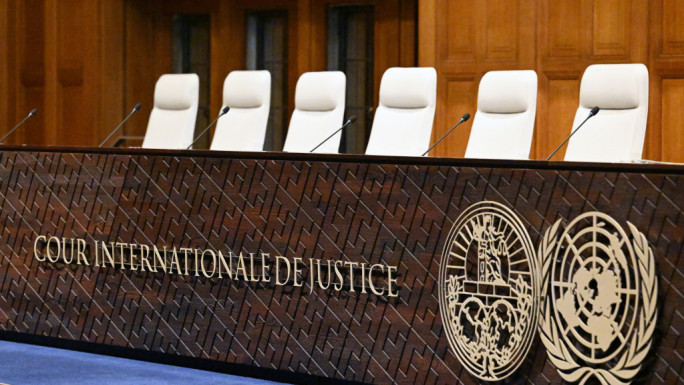
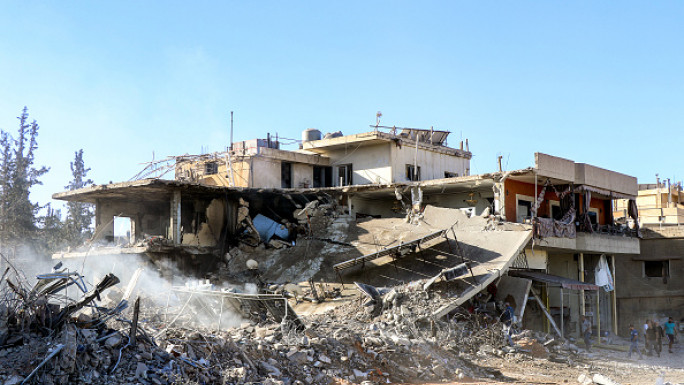
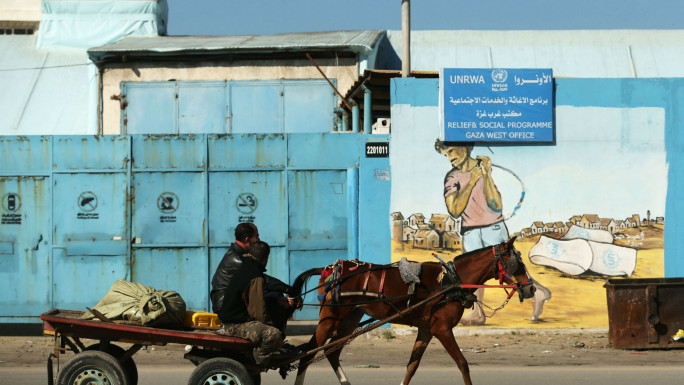

 Follow the Middle East's top stories in English at The New Arab on Google News
Follow the Middle East's top stories in English at The New Arab on Google News
